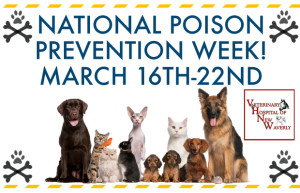Posts by Dr. Lelan Olsen
Pet Obesity Awareness: Tips For Keeping Your Pet Slim & Trim
 Do you know what 88.4 million dogs and cats have in common? They are obese. In a recent study, it was found that 53 percent of adult dogs and 55 percent of adult cats in the United States were classified as being overweight or obese by their veterinarians. Many of these pets were not characterized by their owners as being obese. So in simple terms, fat pets are the new normal in pet ownership.
Do you know what 88.4 million dogs and cats have in common? They are obese. In a recent study, it was found that 53 percent of adult dogs and 55 percent of adult cats in the United States were classified as being overweight or obese by their veterinarians. Many of these pets were not characterized by their owners as being obese. So in simple terms, fat pets are the new normal in pet ownership.
Even though they may be cute, being overweight may be detrimental to your pets health. These extra pounds can put the pets at risk to other disorders such as painful arthritis, heart disease, breathing difficulty, diabetes and even bladder cancer. Obesity not only affects your pets health but also their quality of life.
Certain pets are more likely to be obese. These factors include but are not limited to:
- Breed—Certain breeds such as the Labrador Retriever, Cocker Spaniels and Cavalier King Charles Spaniels tend to more likely affected.
- Age – Older dogs are less active, have less energy, and require less calories.
- Neutering/ spaying – Clinical trials have shown that the basic metabolism is lower in neutered dogs, so they require less calories.
- Medical Problems – Sometimes weight gain can be associated with a medical problem, so a specific treatment may be required.
- Overfeeding – This tends to be the most common problem. Dogs having an unlimited access to food tend to eat more than they need. Also many commercial foods are loaded with salt and fat to improve the taste. This could make your pet want to gorge.
- Feeding habits – Feeding table scraps and “people food” can lead to obesity
- Lack of exercise – As with people, too much food and too little exercise produces a typical result. Obesity
An owner can assess their pets’ weight at home and contact your veterinarian if you think that you have a problem. To do this, I would suggest the following.
- By running your hands along your pet’s ribcage, you should be able to palpate the ribs covered by a thin layer of fat. If you cannot feel the ribs, that could be a sign of an overweight pet.
- Look at your pet from the side. You should see an upward tuck of the abdomen. An overweight pet will have very little to no tuck.
- View your pet from above. There should be a moderate narrowing at the waist just past the ribcage. A straight or bulging line from the ribcage to the hips can indicate and overweight pet.
- A lot of pets will gain weight in the neck area. So if the collar needs loosening, this may indicate obesity.
The most effective way to achieve a healthy weight is to combine increased exercise with changes in your pet’s food or nutrition program. An exercise program should include walking your dog at a constant pace to help burn calories. The program should also include encouraging it to play in the yard or at home. Tossing a frisbee or a ball can also help burn excess calories. It is important to remember that when starting an exercise program, make sure that you ease into exercise. Because an overweight pet is more prone to injury.
A proper diet is essential for your pets overall health and well-being. Balanced nutrition is an important part of an active, healthy lifestyle. A low fat and low calorie diet is essential in helping your pet lose weight and stay fit. Fiber is also an important ingredient since it helps your dog eat less while keeping full. It is important to avoid table scraps and make sure that you account for the treats when considering how much to feed your pet during meals.
Weight loss is important, and your veterinarian is a good place to start. If your pet is obese, a veterinarian can help rule out ailments that can cause obesity and give you advice what foods might be best for your pet. Monitoring its weight loss is also important. A dog should typically lose about 1 pound per month, so monthly weigh-ins will help determine if the program is working for it.
Most things are easier said than done, but that doesn’t always need to be the case. Remember that you are your pet’s will power and are in control of its health. Allowing it to become obese is detrimental, and we know that you don’t want your pet leaving your side any sooner that it needs to. Maintaining a healthy weight is essential to maintaining a long, healthy life. With time and effort on your pet, it will be happier and healthier than ever.
Caring For A Deaf Dog
 It is human nature for everyone to boast that they have the perfect family, including their pets. But sometimes life throws us a curveball and we have to adjust to make it the best possible. Our pets sometimes have impairments like deafness that make it harder for them to adjust to everyday life. During the third week of September we recognize this impairment as Deaf Dog Awareness Week. Whether it is congenital or acquired it can lead to frustrations in training the pet, which isn’t the pet’s fault.
It is human nature for everyone to boast that they have the perfect family, including their pets. But sometimes life throws us a curveball and we have to adjust to make it the best possible. Our pets sometimes have impairments like deafness that make it harder for them to adjust to everyday life. During the third week of September we recognize this impairment as Deaf Dog Awareness Week. Whether it is congenital or acquired it can lead to frustrations in training the pet, which isn’t the pet’s fault.
Deafness can be caused by some hereditary issues which is known as congenital deafness. Hearing loss can also happen due to an ear infection, injury to the ear or it may be due to old age. Loud noises may also cause hearing loss, as can certain drugs.
Congenital deafness is most commonly related to the white coats of dogs. The white coats have unpigmented skin which produces white hair. If there is unpigmented skin in the inner ear, the nerve endings atrophy and die off in the first few weeks of the puppy’s life, resulting in deafness. This deafness can affect both ears or it can affect only one ear.
Early signs that your pet may be deaf is that it plays more aggressively or bites too hard because it is not deterred by the other puppy’s yelp of pain. It may not awaken during feeding time unless it feels vibrations or is bumped by a littermate. The owner may notice that it doesn’t respond to being called when sleeping, too far away or looking at you. There are several tests that you can do at home to assess that your pet is deaf, but the most reliable method is BAER testing. It is 100% reliable in determining if your pet is deaf. This test is a procedure using computers to record electrical activity of the brain in response to sound stimulation.
Outside of the obvious physical defect, deaf dogs are just everyday normal dogs. They play, sleep, and share their lives with us as companions, but they just don’t hear. A person that discovers this will be often faced with many negative warnings from misinformed people but with proper training, your impaired pet can lead a happy and active life. There are very few health considerations that apply to all deaf dogs.
Most people think that they are hard to train which could not be farther from the truth. They just need to be trained with the positive reinforcement approach to training. Since they can not hear, they rely on using visual signs instead of sound. This can be an advantage, since they are more focused and doesn’t have the noise distractions from other pets in the class. They may need more available time spent with them to build a solid foundation for training. So a person that has little time to train them may not be a good match. It is also good to have them interact frequently with other people and dogs.
Since a deaf pet cannot hear, it may be best to take steps to assure their safety. To prevent them from running off, it is important to exercise them on a leash frequently or have them in a fenced area. There are vibration collars available that can aid in getting the dog’s attention to call them back with hand signals.
Pets are always perfect in our eyes, even though some of them are impaired to some degree. If you have any concerns or questions please feel free to contact us.
FAQ’s About Pet Vaccinations
 Vaccinations are part of a basic pet wellness program that the Olsen Veterinary Clinic administers in Glen Carbon and the surrounding area. If you are not familiar with veterinary concerns or have never owned a pet up to this point, it is understandable that you might not know exactly what the pet vaccinations can do to safeguard your pet’s health. As August has been designated National Immunization Awareness Month, here are some frequently asked questions we get from pet owners regarding dog and cat vaccinations.
Vaccinations are part of a basic pet wellness program that the Olsen Veterinary Clinic administers in Glen Carbon and the surrounding area. If you are not familiar with veterinary concerns or have never owned a pet up to this point, it is understandable that you might not know exactly what the pet vaccinations can do to safeguard your pet’s health. As August has been designated National Immunization Awareness Month, here are some frequently asked questions we get from pet owners regarding dog and cat vaccinations.
What is a vaccination?
A vaccination is an injection that is given under the skin to stimulate the production of antibodies by the pet’s immune system against specific infections. They are needed once the antibodies transferred from the mothers to the newborn puppies and kittens wears off, which usually occurs within weeks of birth.
Are pet vaccinations harmful to my pet?
A vast majority of the vaccinations are actually quite safe and cause no illness to the pet. However, some pets may have mild side effects that can include fever, swelling, redness and digestive upset. If this has previously occurred it may be important to let your veterinarian know so that steps can be made to prevent or minimize the side effects.
What are “core vaccinations”?
Core vaccinations are vaccines that protect your pet against a handful of common and dangerous illnesses. Rabies is among the most important, because it is fatal to pets and can be spread easily to humans and other mammals. Because of this, it is important to vaccinate both cats and dogs against rabies. Other vaccinations that are considered core vaccines for your dog include canine hepatitis, parvovirus and canine distemper. While in cats, the core vaccinations include feline calicivirus, feline distemper, and Feline Herpes Virus along with the rabies vaccine.
What other vaccinations should I consider?
There are other diseases that can affect your pet. Here we tailor the vaccinations depending on the probable risks that your pet might incur. If your dog is quite mobile, groomed or boarded, or is in contact with other dogs, we would recommend vaccinating for Bordetella or as it is commonly known as “kennel cough.” Another disease that is becoming more prevalent seen in dogs is Canine Influenza. This disease is also contracted by contact with infected animals, so this may be one to consider. Finally if your pet is in contact with a lot of ticks or is in the woods, I would possibly recommend vaccinating to protect your pet from Lyme disease which is carried by the deer tick.
Why does my pet need booster shots?
Just as the original immunity provided from the mother’s milk fades over time, prescribed vaccines have a limited protective span. They can wear off over time and then your pet will be vulnerable to the diseases which can be deadly. The booster shots help keep the level of immunity consistent to ensure the best possible protection for life.
How often must the vaccinations be updated?
The vaccinations provide protections for different lengths of time. Some may be one year, for example rabies, while some can be longer. Since we tailor the vaccination schedule to meet your needs, we can provide you a schedule showing when each vaccine should be updated. If you happen to miss a scheduled update, it is best to bring your pet in as soon as possible so that the protection will not decrease.
The Olsen Veterinary Clinic urges pet owners to schedule the necessary pet vaccinations and updates with your veterinarian. By keeping your pet vaccinated properly, you will help to ensure that your pet has a long and healthy life.
Three Keys To Water Safety For Dogs
 Oh, the sounds of summer! Many people and their pets will spend numerous hours this summer basking on a beach, boating in a lake, or even lounging by a pool in their own backyard. Many pets love being around water, but each year approximately 40,000 pets lose their lives in drowning accidents. You need to look out for your pet around water, since even the strongest, most enthusiastic swimmers can get into trouble. The keys to water safety for dogs are prevention, preparedness and awareness.
Oh, the sounds of summer! Many people and their pets will spend numerous hours this summer basking on a beach, boating in a lake, or even lounging by a pool in their own backyard. Many pets love being around water, but each year approximately 40,000 pets lose their lives in drowning accidents. You need to look out for your pet around water, since even the strongest, most enthusiastic swimmers can get into trouble. The keys to water safety for dogs are prevention, preparedness and awareness.
Prevention
Believe it or not, not all breeds are Micheal Phelps-type swimmers. For example, the Bassett Hound and English Bulldog just are not built for swimming, so it is important to have a secure fence and gate around your pool and never leave your pet unsupervised.
Make sure that your pet can get out of the pool. If it jumps or falls in, it may panic and drown. Even the strongest swimmers can tire easily.
If you are taking your pet boating or in a river or ocean, it may be wise to invest in a dog floatation device and use it. Just like people, it’s easy for your pet to develop a cramp and become exhausted too far from shore or get overwhelmed by the tides.
Preparedness
Since pools are filled with chemicals that control the water and algae, and lakes and ponds can be a common source for parasites, it may be a good idea to bring fresh drinking water for your pet. The chemicals and parasites can cause your pet to become ill, which may lead to vomiting, diarrhea and other health issues.
One of the best things that you can do is to take courses in pet first aid and CPR. These are available at many local Red Cross chapters and sometimes taught by a local veterinarian. A near-death dog rescued from the water may be saved by your prompt actions—if you know what to do.
As I mentioned before, if your dog isn’t much of a swimmer or is older and debilitated, get him a personal floatation device. These are especially great for family boating trips, because most have study handles for rescue when a pet goes overboard. It is also important to keep a long leash on the boat at all times in case you need to restrain your pet for any reason.
It is also important to bring fresh water to rinse off your pet after swimming to get out the chlorine and other pool chemicals, as well as bacteria and dirt he might get on him from an ocean or lake. Don’t let your dog sit in a wet collar as hot spots can develop as well.
Awareness
Be aware of your dog’s condition as he plays. Remember that even swimming dogs can get hot, so bring fresh water and offer it at every opportunity. When your dog is tiring, call it a day. A tired dog is a good dog, but an exhausted dog is in danger of drowning.
Be particularly careful with young and old dogs. Young dogs can panic in the water and old dogs may not realize that they aren’t as strong as they used to be. Keep them close to shore, and keep swimming sessions short.
During the hot summer, many dogs are drawn to water to cool off and swimming also meet your dog’s exercise needs with a low-impact option of movement. But accidents can happen in a hurry. So try to prevent these accidents by being prepared and aware. If you have any further questions, please feel free to contact us.
Should I Adopt A Cat Or A Dog?
 It is always a good time to adopt pets, but June has been designated cat adoption month. By far the most common pets are dogs and cats. If I asked a person the difference, I would probably get a strange look and an answer like “one barks and growls, where the other meows and purrs.” But there are other differences that affect them as to whether they may be the right pet for your family.
It is always a good time to adopt pets, but June has been designated cat adoption month. By far the most common pets are dogs and cats. If I asked a person the difference, I would probably get a strange look and an answer like “one barks and growls, where the other meows and purrs.” But there are other differences that affect them as to whether they may be the right pet for your family.
First off, dogs need to be cared for, whereas cats are independent. Dogs are descendants of pack animals. Dogs like company and will never be bored if one spends a lot of time with it. Their pack mentality allows the dogs to be trained more easily as they crave attention. On the other hand, cats love to spend a lot of time alone. Cats are solitary hunters that are more attached to their environment than they are to other cats.
The pack behavior also relates to how a dog is built physically. In the wild they are designed to run down their prey. This translates to dogs being built as long distance runners. Dogs need a lot of space as they love to run around. Cats are designed to stalk their prey. Their instincts lead them to sneak up on their prey and then pounce. This leads to cats being built more as sprinters rather than long distance runners. Contrary to dogs, cats are very happy in small places.
When looking at the nature of dogs and cats, the former loves to please you, but the latter always love to please themselves. Well, dogs are more affectionate when compared to cats. Dogs will wag their tail, and even their whole body, to show affection. A cat will only show affection by allowing you to scratch it behind the ears.
Unlike dogs, cats are lap animals. A cat will tolerate being smooched, but on the other hand, you will be smooched by a dog. Dogs are happy to see you when it is awaken from sleep, but a cat will just pretend to be sleeping, even if you try to wake it.
Dogs tend to be your friends at night and protect you from harms way by scaring the intruders. Cats, they will just run for cover.
By knowing your lifestyle, you can determine what pet is best for you. Dogs are more social, require more attention and space. Cats on the other hand tend to be happy being by themselves and don’t require as much attention and space. Both species can be rewarding pets.
If you have any questions about the right pet for you, please contact our office!
Early Detection Of Pet Cancer
 Did you know that cancer is the number one disease-related killer of pets? Statistics show that one out of four dogs develop cancer while one out of five cats develop some form of cancer. Cancer is a broad term used to describe cells within the body that are growing and dividing in an abnormal manner and rate. These cells divide at uncontrolled rates and ofter form masses or tumors. Some growths can be benign while some may be malignant.
Did you know that cancer is the number one disease-related killer of pets? Statistics show that one out of four dogs develop cancer while one out of five cats develop some form of cancer. Cancer is a broad term used to describe cells within the body that are growing and dividing in an abnormal manner and rate. These cells divide at uncontrolled rates and ofter form masses or tumors. Some growths can be benign while some may be malignant.
Since May has been designated Pet Cancer Awareness Month, I would like to offer some tips to pet owners to aid in early detection and possibly help extend the life of your pet. With regular checkups, early detection and diagnosis can possibly improve the odds of treating the cancer effectively.
Lumps and Bumps: Not all lumps and bumps are cancerous but there is no way to know for sure without getting your veterinarian involved. This is especially true if they are not resolving on their own. A veterinarian may do a needle biopsy and look at the cells in the mass under a microscope. By catching them early, complete removal can be achieved.
Abnormal odors: If you notice abnormal odors from your pets mouth, ears or other parts of their body, I would recommend having it checked out. There could also be a change in your pets food preference like soft or hard or the manner in which it chews. A veterinarian may want to take some radiographs or have a CT scan done to visualize a mass being present.
Abnormal discharge: If you notice blood, pus, vomiting, diarrhea, abdominal distention or bloat on your pet, you may want to get your pet an appointment. Your pets’ abdomen may be distended because of a tumor in the abdomen or it may be distended indicating bleeding in the abdomen. Bleeding from the mouth or other body parts in a young dog usually indicates a bleeding disorder, but in older dogs cancer could be a distinct possibility. Radiographs or an ultrasound could aid in the detection.
Wounds not healing: If your pet has wounds that are not healing, you may want to get your pet examined. This symptom may be a sign of infection, skin disease or cancer. A lot of times, the tumors outgrow their blood supply, so they can become necrotic and have continuous drainage issues.
Weight loss: If your pet has experienced sudden weight loss it is important that this is mentioned to your veterinarian. Sudden weight loss with other clinical signs could be an indication of cancer. If your pet has cancer, proper nutrition is essential for its’ strength.
Appetite change: Pets just don’t stop eating without a cause. This may not be cancer, but it is important to mention to your veterinarian. If your pet has oral tumors, there may be difficulty or pain when chewing or swallowing. If this is occurring, by all means a visit to your veterinarian is important.
Cough and difficulty breathing: This could be a sign of heart disease or lung disease, but this is the most common sign of lung cancer. Some cancer metastasize through the lungs and lead to the symptoms of coughing which consists of a dry, nonproductive cough.
Lethargy/depression: If your pet is sleeping more, less playful, or less willing to go on walks or exercise, this may be a sign of cancer. So do your pet a favor and have him visit your veterinarian.
Changes in bathroom habits: Frequent or straining to urinate or defecate may be a sign of cancer. Also blood in the urine or stool may also be an indication. This may only be a urinary tract infection, but if straining and bleeding cannot be rapidly controlled or recurrent, it may be cancer.
Evidence of pain: Unexplained lameness or pain could possibly be an osteosarcoma, which is bone cancer. If your pet is reluctant to walk, run, or jump, this may be arthritis or joint or muscle disease. But it could also be cancer, especially if it is a large or giant breed. Radiographs can aid in the diagnosis.
Cancer is the number one disease afflicting older pets and early detection is the key to successfully treating your pet. There are several options that await us if it is diagnosed. These may include surgery, chemotherapy, radiation, immunotherapy, targeted therapy, or vaccines.
As always, we appreciate that your pet is part of your family. If you have any questions or concerns, do not hesitate to contact our office.
How To Prevent Hairballs In Your Cat
 There is not many things worse than laying in bed and listening to your cat hacking, gagging and retching at night and then getting up and stepping on a disgusting hairball with your bare feet in the morning. Let alone it being on your newly cleaned carpet.
There is not many things worse than laying in bed and listening to your cat hacking, gagging and retching at night and then getting up and stepping on a disgusting hairball with your bare feet in the morning. Let alone it being on your newly cleaned carpet.
Even though hairballs may be a topic of jokes, they can pose a danger to your cat by potentially blocking the intestines. Sometimes veterinary care may be necessary which can lead to surgical intervention.
The scientific name for a hairball is a trichobezoar. It is the unsavory by-product of a good, clean habit. This damp wad of undigested hair that is moistened by bile and other digestive fluids and tend to be “cigar-shaped” because when we see them, they have been regurgitated through the esophagus which is tube shaped. Some are normal, but as the cat continues to groom itself, the hair fibers are guided down to the stomach by the tongue and form. As they form, this can lead to discomfort, vomiting, anorexia, and diarrhea. The retching can sometimes be confused with asthma, so it is best to have it checked out by your veterinarian.
There are a number of effective ways to avoid and prevent hairballs. Used routinely, they can help hairballs from forming and you won’t need that terrifying trip to the veterinary clinic.
The number one thing is to brush your cat frequently. Not only do they like it, but you remove the loose hair. Brushing is the fastest and easiest way to reduce hair ingestion and it keeps it off your furniture also. One that is really good is called “The Furminator”. They are really durable and are found at all the pet stores.
A lot of owners feed their pets a hairball formulated diet. These formulas contain beet pulp, carbohydrate blends and a fruit or vegetable extract known as FOS that promotes healthy stomach bacteria. This combination of ingredients not only helps to reduce hairballs, but it also enhances your cat’s ability to absorb nutrients, provide bulk to move food through the intestine, promote colon health and reduces waste and litter box odors.
Commercial products like Laxatone or CatLax provide assistance by lubricating action or providing soft bulk or both. These products contain mineral oil and sometimes can deplete the body of vitamin A if taken in large quantities.
Homeopathic remedies such as butter two to three times a week as well as pumpkin or squash have been used with success. The pumpkin and squash also may help with constipation or diarrhea because of the added fiber.
Lastly there are products that are edible emulsifiers that break down the fat in the hairball. Nestle Purina studied hairballs and found that they were composed of a lot of fat in the mix. This product which contains soy lecithin breaks down the existing hairball and allows it to pass more easily through the digestive tract and minimizes the formation of new hairballs. The product that we have in our clinic here is called Capilex and we have had some good results with it.
Hairballs are an unpleasant side effect of your cat’s natural inclination to stay clean and beautiful. Our job as owners is to allow that self-grooming but take responsible steps to make sure it doesn’t result in a dangerous, albeit hairy, health hazard.
As always if you are concerned about your pet’s health, contact our office and we can find the best solution for you and your pet.
National Poison Prevention Week For Pets
 Did you know that the third week of March is designated National Poison Prevention Week? The Pet Poison Helpline wants everyone to remember the four-legged members of your family. About 90% of the calls to the helpline involve dogs because they tend to be more curious, unpredictable, and indifferent to eating just about anything.
Did you know that the third week of March is designated National Poison Prevention Week? The Pet Poison Helpline wants everyone to remember the four-legged members of your family. About 90% of the calls to the helpline involve dogs because they tend to be more curious, unpredictable, and indifferent to eating just about anything.
Many products that are kept around your house can be toxic to your pet, so it is important to keep the Pet Poison Helpline number to contact if needed. That number is 1-800-213-6680. If an emergency occurs, they are available to help and assist the frantic owner.
As with almost everything else, prevention is best, so here are some pointers to help prevent poisoning. By taking note, this can reduce the exposure to poisons.
- Never give your pet any medications unless specifically instructed to do so by your veterinarian. Tylenol is a common medication to help relieve your headache, but it can be deadly to your pet. As little as one 500mg tablet can kill a cat.
- If you use flea control, always read the label directions for proper application. Never put a flea control product on your cat that is for a dog or vice versa. Permethrin is a product in flea controls that is extremely toxic to cats. As a matter of fact, a few drops can potentially be life-threatening.
- Be aware of some houseplants. They may be pretty, but they can also be toxic to eat or chew on. This is not a problem in human adults, but pets and children love to explore, chew and taste. Plants like oleander, rhododendrom, azaela and yews can affect the heart and be cardiotoxic. Rhubarb can cause kidney damage and some mushrooms can cause liver damage.
- While essential to a car’s cooling system, antifreeze can be fatal to cats and dogs. It is sweet-tasting and as little as one lick can be deadly. It is important to sweep up all spills and keep it locked away from pets. It may be more expensive, but a safe antifreeze alternative could prevent accidental exposure.
- If you apply weed killer or insecticide to your lawn or fertilize your plants or garden, remember to follow label directions for proper applications and do not allow pets access to these areas until the amount of time listed on the label by the manufacturer has passed ant the product has dried thoroughly. Your pet could become exposed by licking its’ paws after walking through treated areas when wet or before access should be allowed.
- Alway store lawn and garden products in areas that are inaccessible to animals such as locked storage sheds or garages. These products can include rodenticides, slug and snail baits, paint, oil and gasoline that are potentially dangerous chemicals to name a few. Rat poisons are a bait to attract the rodent, and this works on rodents as well as pets. Even if it is hidden or seemingly out of your pet’s reach, determined pets may be creative to reach the bait. Also, rodents that have died from the poison and are ingested by pets pose a risk.
- Meat and food scraps mixed with discarded household cleaner containers and other trash are a recipe for disaster on many levels! Even “good pets” who usually don’t get into garbage may get an inclination due to what they smell or if they are bored and hungry. It is important to protect your pets from getting into the trash by securing all your garbage cans with tamper-proof lids. For extra protection, you may want to keep them safely out of reach in the cupboard or shed.
- If you are unsure about proper usage of any product, please call the manufacturer and/or your veterinarian for instructions. It is also helpful to keep hydrogen peroxide or Syrup of Ipecac on hand to induce vomiting if instructed by your veterinarian.
If you suspect that your pet has ingested a potentially poisonous substance, immediately call your veterinarian or the Pet Poison Helpline. Again their number is 1-800-213-6680. In most instances, early detection and prompt treatment may help reduce the risk of developing clinical signs or increase the chances of a successful recovery if signs are present. It will help to note what you think your pet has eaten, when he ingested the substance in question and any problems he is experiencing.
Why Should I Vaccinate My Pet?
“I figured, what’s the worse that could happen? If he got sick, I’d take him to the vet. Well, he got sick. Real sick. It kills me to think about how scared, how weak he looked, and how despondent my kids were. He was the star of the house. And he was gone, just like that.”
Some days in our clinic, we see this. Clients bringing in their lifeless pets for us to treat and nurse their beloved pet back to health. Sometimes this could have been preventable if only they had vaccinated their pet.
If you have paid attention to the media, there is a lot of discussion on whether you should vaccinate your children or not. Unfortunately, this discussion also crops up in veterinary medicine—whether to vaccinate your pet or not.
There are only two reasons to vaccinate. They are to protect your pet and protect the pets and people around us. Cat and dog diseases still exist and can infect any pet that is not protected. You never know when or where your pet can be exposed. Vaccinations are the best way to stimulate the immune system to stop diseases when exposed and for the vast majority of pets, the benefits of vaccinating far outweigh the risks.
We can’t depend on other pet owners to provide the proper vaccinations to their pets so that our pet has less opportunity to get a disease. So by vaccinating we are cooperating will all individuals to reduce the possibility of spreading disease.
There are several reasons that you should vaccinate your pets. The first and foremost is that with some diseases, it is the law. It is mandatory that you have your pet vaccinated against rabies in every U.S. State. Even pets kept indoors can potentially be exposed if the get out unexpectedly or an uninvited animal gets in the house. The important thing about rabies is that humans can get it and it is fatal.
Several diseases can be transmitted from pets to humans such as rabies and Leptospirosis. Vaccinating your pet helps reduce the risk of human infection and is especially necessary if there are young, elderly, or immune-compromised members in your household.
Many people have their pet groomed, boarded, or attend doggy daycare. If you do, most places require that you pet have a vaccine against kennel cough. This disease is a hacking cough that is highly contagious. Although the disease is relatively mild, it can sometime lead to severe pneumonia.
Young unvaccinated puppies are at risk to contracting parvovirus. This is a severe life-threatening infection that causes bloody diarrhea and vomiting to the point of shock and even death. Parvovirus is extremely contagious and puppies are most at risk. This disease is almost 100% preventable with vaccination.
Puppies can get a severe neurological, dermatologic, and respiratory disease called distemper. Most dogs that contract distemper and euthanized due to the progressive nature of the disease. This disease can also be prevented by timely vaccinations.
There are other diseases such as hepatitis, Lyme disease, and Leptospirosis that can be prevented by vaccinating your puppies.
Believe it or not vaccinating can save money. Most veterinary vaccinations are relatively inexpensive. Vaccinations are definitely less expensive that the cost of treatment for the diseases that they protect against.
An ounce of prevention really is worth a pound of cure. Many dangerous diseases seen in dogs and cats are completely preventable with the right vaccinations. Vaccinating gives pet owners peace of mind and helps pets lead safe and healthy lives.
If you have questions, or are still unsure about vaccinations for your pet, contact our office today.
Questions For New Pet Owners To Ask Their Vet
 Congratulations! Welcome to the world of pet ownership. This might have happened to you over the holiday season. As responsible pet owners, it is important to keep your pet healthy and a good way to do that is to develop a relationship with a veterinarian. As with a person choosing their own physician, it is important to find a veterinarian that meets their needs, as well as getting the right sense of education, experience and personality.
Congratulations! Welcome to the world of pet ownership. This might have happened to you over the holiday season. As responsible pet owners, it is important to keep your pet healthy and a good way to do that is to develop a relationship with a veterinarian. As with a person choosing their own physician, it is important to find a veterinarian that meets their needs, as well as getting the right sense of education, experience and personality.
Before you meet with a potential veterinarian, learn as much about the practice as you can by reading the clinic’s website, search the vet’s Facebook or Twitter page and see what their clients are saying. Maybe look for testimonials and note any red flags that may present. It may be helpful to schedule a meeting with the veterinarian-not for an exam, but to see what chemistry the veterinarian has with your pet. And then take the information gathered and decide if maybe they might be a good fit for you.
A pet owner must consider the health of their pet and tailor questions to address any needs or conditions that he or she has, especially if your pet may need specialized care in the future. The owner needs to consider the veterinary clinic’s policies and make sure that they meet the owner’s criteria. As in almost every situation, communication is important. It is important that you can get in touch with your veterinarian when you need to. Make sure the practice and your specific vet have open lines of communication, and know all the channels you can use to contact them.
With that in mind, here are some possible questions that you may want to ask a new veterinarian.
- How many veterinarians are in the practice? Will you see the same veterinarian every time or do the doctors switch or rotate without notice?
- How far in advance does the practice typically schedule appointments?
- If you need same-day care, will the practice see you or refer you to an emergency veterinarian?
- What are the qualifications of the technical staff? If your pet needs a simple procedure can you see a tech or do you need an appointment with the main vet?
- If your pet has a specific disease or ailment, does the veterinarian have experience treating that condition?
- Are the veterinarians open to alternative treatments like chiropractic care or acupuncture?
- Does the practice offer emergency or after-hours care? If not, where would the practice send you?
- In case referral work is needed, where does the veterinarian send them?
- What is the best way to contact the veterinarian during the business day and after hours?
- Is the veterinarian willing to answer questions via email?
There are many good veterinarians in practice out there, so finding an appropriate one may take some time and extra research. But in the long run, the task may be less challenging and lead to fewer problems by taking time to find one that meets your criteria.

